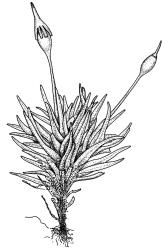Plants forming cushions or turves, mostly on rock, not lustrous. Stems erect, simple, or branched by forking, in cross-section with a central strand. Leaves oblong-lanceolate, ovate-lanceolate, linear-lanceolate, or linear, ± sheathing or spreading when moist, crisped when dry; mid and upper laminal cells small, mostly rounded-quadrate, firm-walled, often partially bistratose; basal cells more elongate; alar cells not differentiated. Costa ± percurrent.
Autoicous or rarely dioicous. Perichaetial leaves not differentiated or sheathing. Setae erect and straight or cygneous, single or sometimes multiple; capsules erect, symmetric, exserted, and smooth; stomata present at capsule base, superficial; annulus differentiated; operculum rostrate. Peristome single; teeth broadly lanceolate, variously perforate or irregularly split into 2–3 papillose divisions, rarely united in pairs. Calyptra mitrate, deeply lobed and usually plicate, covering c. ½ or the entire capsule, lacking hairs but sometimes scabrous at apex. Spores spherical.
The Ptychomitriaceae were treated by Brotherus (1925) to include three genera (Ptychomitrium, Glyphomitrium, and Campylostelium) of which Ptychomitrium is the largest. Buck & Goffinet (2000) expanded the family to include the small African genus Ptychomitriopsis Dixon. More recently Goffinet et al. (2009) presented an altered view of the family in which they excluded Glyphomitrium Brid., but added three other genera (all previously placed in the Grimmiaceae), for a total of six genera. Morphologically, the genera are usually differentiated using features of the perichaetia, the setae, and the calyptrae. However the family is circumscribed, Ptychomitrium is by far the largest genus, and is distinguished by having non-differentiated and non-sheathing perichaetial leaves, straight setae, and lobed and plicate calyptrae that do not enclose the entire capsule. Ptychomitrium is the only genus that occurs in N.Z.
The family was traditionally placed in the order Isobryales (sensu Brotherus 1925) near to the Orthotrichaceae, but Goffinet et al. (2009) placed it near the Grimmiaceae in the order Grimmiales (subclass Dicranidae). The demonstration by Edwards (1978) that the arrangement of the amphithecial cells (from which the peristome develops) in Ptychomitrium is haplolepideous in nature provided support for the latter placement.
| Category | Number |
|---|---|
| Indigenous (Non-endemic) | 1 |
| Total | 1 |




